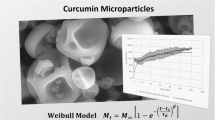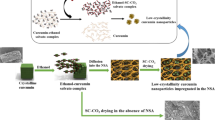Abstract
Curcumin has strong coloring power, safety and innocuity, comprehensive pharmacological function, but its low stability and water insoluble limit its application. Curcumin microcapsules were prepared by spray-drying process using porous starch and gelatin as wall material here. Results showed optimal condition as follows: the ratio of core and wall material of 1/30, embedding temperature of 70 °C, embedding time 2 h, inlet gas temperature of 190 °C, feed flow rate 70 mL/min and drying air flow 70 m3/h, at which the microencapsules had good encapsulation efficiency. The stability of microencapsulation curcumin against light, heat, pH was effectively improved and its solubility was increased greatly. This study would be helpful to the industrial application of curcumin.





Similar content being viewed by others
References
Anant P, Anshuman A, Bhimrao K, Mahadik K (2004) Characterization of curcumin-PVP solid dispersion obtained by spray dry. Int J Pharm 271:281–286
Augustin MA, Sanguansri L, Margetts C, Young B (2001) Microencapsulation of food ingredients. Food Aust 53:220–223
Bimenet JJ, Bonazzi C, Dumoulin E (2002) Drying of foodstuffs. Drying 2002. In: Proceeding of the 13th international drying symposium, pp 64–80
Bo S, Wenli Y, Yaping Z, Xiaoyong L (2006) Study on microencapsulation of lycopene by spray-drying. J Food Eng 76:664–669
Brazel CS (1999) Microencapsulation: offering solutions for the food industry. Cereal Foods World 44:388–393
Dursch S, Schwarz K (2006) Microencapsulation properties of two different types of n-octenylsuccinate-derivatised starch. Eur Food Res Technol 222:155–164
Dziezak J (1988) Microencapsulation and encapsulated food ingredient. Food Technol 42:136–147
Giusti MM, Wrolstad RE (1996) Radish anthocyanin extract as a natural red colorant for maraschino cherries. J Food Sci 61(4):688–694
Gouin S (2004) Micro-encapsulation: industrial appraisal of existing technologies and trends. Trends Food Sci Technol 15:330–347
Hanne HT, Mar M, Thorsteinn L (2002) Studies of curcumin and curcuminoids. XXVII. Cyclodextrin complexation: solubility, chemical and photochemical stability. Int J Pharm 244(12):7–135
Heinta J, Krober H, Teipel U (2001) Microencapsulation of reactive materials. Schuettgut 7:27–32
Hesham AA, Kok KP, Yvonne TFT (2007) Solubility of core materials in aqueous polymeric solution effect on microencapsulation of curcumin. Drug Dev Ind Pharm 33:1263–1272
King AH (1995) Encapsulation of food ingredients: a review of available technology, focusing on hydrocolloids. In: Risch SJ, Reineccius GA (eds) ACS symposium series. Encapsulation and controlled release of food ingredients, vol 590, pp 26–39. American Chemical Society, Washington
Kondo T (2001) Microcapsules: their science and technology Part III. Industrial, medical and pharmaceutical applications. J Oleo Sci 50:143–152
Liu Z, Zhou J, Zeng Y, Ouyang X (2004) The enhancement and encapsulation of Agaricus bisporus flavor. J Food Eng 65:391–396
Liu XD, Atarashi T, Furuta T, Yoshii H, Aishima S, Ohkawara M (2001) Microencapsulation of emulsified hydrophobic flavours by spray drying. Dry Technol 19:1361–1374
Matsuno R, Adachi S (1993) Lipid encapsulation technology—techniques and applications to food. Trends Food Sci Technol 4:161–256
Mofidi N, Aghai M, Sarbolouki MN (2000) Mass preparation and characterization of alginate microspheres. Process Biochem 35:885–888
Perez AC, Baez GJG, Beristain CI, Vernon CEJ, Vizcarra MMG (2003) Estimation of the activation energy of carbohydrate polymers blends as selection criteria for their use as wall material for spray-dried microcapsules. Carbohydr Polym 53:197–203
Rosenberg M, Kopelman IJ, Talmon Y (1990) Factors affecting retention in spray-drying microencapsulation of volatile materials. J Agric Food Chem 38:1288–1294
Ruben B, Luis R, Katy Y, Georgina D, Claudio R (2003) Oxidative stability of carotenoid pigments and polyunsaturated fatty acids in microparticulated diets containing krill oil for nutrition of marine fish larvae. J Food Eng 56:289–293
Sampathu SR, Lakshminarayanan S, Sowbhagya HB, Krishnamurthy N, Asha MR (2000) Use of curcumin as a natural yellow colourant in ice cream. Paper presented at National Seminar on Natural Colouring Agents, February 2000, Lucknow, India
Schuck P (2002) Spray drying of dairy products: state of the art. Lait 82:375–382
Sebastien G (2004) Microencapsulation: industrial appraisal of existing technologies and trends. Trends Food Sci Technol 15:330–347
Soper JC, Thomas MT (1997) Enzymatically protein encapsulation oil particles by complex coacervation. US pat. 6-039-901
Sowbhagya HB, Sampathu SR, Vatsala CN, Krishnamurthy N (1998) Stability of curcumin, a natural yellow colourant during processing and storage of fruit bread. Beverage Food World 25(4):40–43
Sowbhagya HB, Smitha S, Sampathu SR, Krishnamurthy N, Bhattacharya S (2005) Stability of water-soluble turmeric colourant in an extruded food product during storage. J Food Eng 67:367–371
Spilgies H (1998) Investigations on the photostability of cephalosporins and beta-lactamase inhibitors. Thesis Munchen 67(9):89–92
Thoma K, Kubler N (1997) Einfluss von Hilfsstoffen auf die Photozersetaung von Arzneistoffen. Pharmazie 52(8):122–129
Zbicinski I, Delag A, Strumillo C, Adamiec J (2002) Advanced experimental analysis of drying kinetics in spray drying. Chem Eng J 86:207–212
Acknowledgments
This work was supported by the Youthful Scientific Innovation Foundation of Nanjing Agricultural University(no. 29972020).
Author information
Authors and Affiliations
Corresponding author
Rights and permissions
About this article
Cite this article
Wang, Y., Lu, Z., Lv, F. et al. Study on microencapsulation of curcumin pigments by spray drying. Eur Food Res Technol 229, 391–396 (2009). https://doi.org/10.1007/s00217-009-1064-6
Received:
Revised:
Accepted:
Published:
Issue Date:
DOI: https://doi.org/10.1007/s00217-009-1064-6




